2020 NFL draft: Possible first-round QB Jacob Eason lands at No. 87 in our rankings
Leading up to the 2020 NFL draft, which starts April 23, Yahoo Sports will count down our top 100 overall prospects. We’ll count them down in groups of five and 10 at a time, followed by in-depth reports on our top 50 players. We reserve the right to make changes to players’ grades and evaluations based on injury updates, pro-day workouts or late-arriving information from NFL teams.
Previous prospect rankings: Nos. 100-91 | 90-81 | 80-71 | 70-66 | 65-61 | 60-56 | 55-51 | 50. DT Justin Madubuike | 49. CB Damon Arnette | 48. OT Ezra Cleveland | 47. WR KJ Hamler | 46. CB A.J. Terrell | 45. RB Cam Akers | 44. DL Ross Blacklock | 43. OT Josh Jones | 42. DT Jordan Elliott | 41. C Cesar Ruiz | 40. S Kyle Dugger | 39. EDGE Terrell Lewis | 38. WR Laviska Shenault Jr. | 37. S Grant Delpit | 36. Jonathan Taylor | 35. WR Brandon Aiyuk | 34. EDGE Zack Baun | 33. EDGE Yetur Gross-Matos | 32. CB Jeff Gladney | 31. QB Jordan Love | 30. CB Trevon Diggs | 29. EDGE A.J. Epenesa | 28. RB JK Dobbins | 27. WR Justin Jefferson | 26. WR Tee Higgins | 25. S Xavier McKinney | 24. WR Jalen Reagor | 23. CB Kristian Fulton | 22. RB Clyde Edwards-Helaire | 21. WR Denzel Mims | 20. LB Kenneth Murray | 19. RB D’Andre Swift | 18. QB Justin Herbert | 17. LB Patrick Queen | 16. WR Henry Ruggs III | 15. EDGE K’Lavon Chaisson | 14. WR Jerry Jeudy | 13. OT Mekhi Becton | 12. DT Javon Kinlaw | 11. OT Andrew Thomas | 10. OT Tristan Wirfs | 9. WR CeeDee Lamb | 8. OT Jedrick Wills Jr. | 7. CB CJ Henderson | 6. LB-S Isaiah Simmons | 5. DT Derrick Brown | 4. QB Tua Tagovailoa | 3. CB Jeffrey Okudah | 2. QB Joe Burrow | 1. Chase Young

90. Utah S Julian Blackmon
6-foot, 187 pounds
Yahoo Sports draft grade: 5.77
The lowdown: Moving from cornerback to safety before the 2019 season was a terrific move for Blackmon’s NFL prospects. He went from a player who suffered coverage lapses in 2018 to an intriguing prospect whose skills appear to better fit his new position. Blackmon was primarily the middle-field safety in the Utes’ talented defense, but he also spent time in the box and covering the slot (extensively in the 2019 Washington game).
Although he’s not a special physical specimen, Blackmon showed that he has suitable traits and can better harness his toughness and closing speed at safety. He’s still developing his instincts for the position and needs to do a better job finding the ball with his back turned. Scouts also appreciate his serious, businesslike approach to the game and believe it will serve him well in the pros.
Blackmon’s versatility, physical style and good range also suggest he’s an ascending prospect who could develop into a very nice complementary piece to a secondary and on special teams. Watch Blackmon, from his deep-safety spot, recognize the screen — likely from film study — and race 17 yards to stop the Oregon pass catcher in the backfield early in the Pac-12 title game:
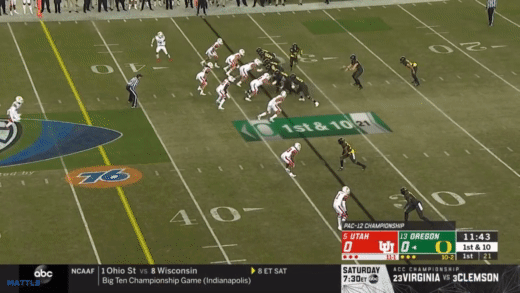
Unfortunately, Blackmon suffered a non-contact knee injury on loose sod later in that game, and it caused him to miss some pre-draft workouts, including at the NFL scouting combine. It has hurt his draft stock, but Blackmon reportedly could be ready during the 2020 season.
By the numbers: Despite missing two games (and most of a third), Blackmon tied for the Pac-12 lead with four interceptions in 2019. Over the past three seasons, Blackmon logged nine picks.
Interesting fact: His older brother, Jarriesse, played basketball at UC Santa Barbara after the brothers played basketball together at Layton (Utah) High School, leading that team to a state title.
The brothers are really close, and they had a fun bit of symmetry. On Nov. 24, 2018, Jarriesse tied his career high for points (12) and recorded his first career double-double as a senior in a win over Idaho. A few hours later, Julian recorded his first career pick six — after the Utes fell behind 20-0 — in a win over BYU.
Draft range: Day 3, with his medical reports determining how high or low he goes in that range.
89. Ohio State DT DaVon Hamilton
6-foot-4, 320 pounds
Yahoo Sports draft grade: 5.78
The lowdown: With each season, Hamilton’s impact on the Buckeyes grew steadily — and he peaked in 2019 as one of their most important front-seven defenders.
After starting only three games his first three seasons (all in 2018), Hamilton earned a starting role as a senior and had career highs in tackles (28), tackles for loss (10.5) and sacks (six).
With his excellent power (33 reps on the bench press) and strong leg drive, Hamilton is a disruptor up front. He can take on double teams fairly well and does a good job locating the ball in traffic from his nose-tackle spot, even if he gets too high in his stance at times. Hamilton also showed nice versatility, lining up regularly across from offensive tackles and displaying enough quickness to project as a 5-technique in the league.
His snap counts were kept relatively low the past two seasons (just over 25 per game on average), and some of that is because the Buckeyes had a strong collection of talent up front. NFL teams are a bit leery of a heavier player (he weighed 327 at the Senior Bowl) whose snap counts are low and whose combine workouts were considered below-average for the position.
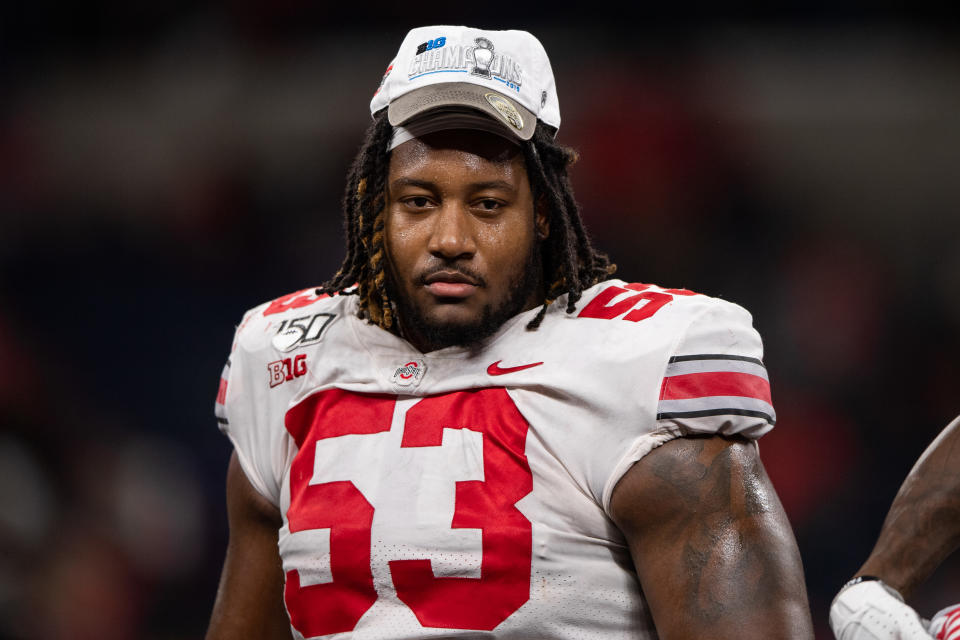
Still, there’s a belief that his ceiling is high, especially with his dominant stretch over the second half of the season. From the first Wisconsin game (when he taxed our No. 95 prospect, C Tyler Biadasz) through the playoff loss to Clemson, Hamilton was one of the better interior rushers in the country — and did so, for two of those games, without a suspended Chase Young on the field.
As Hamilton develops more of a pass-rush plan and evolves from his bull-rush and push-and-pull blueprint, some believe he can become a Domata Peko type of defender.
By the numbers: Despite modest career production, Hamilton has shown a knack for making plays behind the line of scrimmage — 31.8 percent of career tackles were for losses, and that rose to 37.5 percent in 2019.
Interesting fact: Hamilton hadn’t registered a sack before 2019.
Draft range: Round 3 or 4
88. Utah EDGE Bradlee Anae
6-foot-3, 257 pounds
Yahoo draft grade: 5.78
The lowdown: Anae is a high-strung, highly active pass rusher who can wear down offensive tackles with his relentless effort and nasty disposition. After an eye-opening sophomore season in 2017 (10 TFLs, seven sacks, three forced fumbles), Anae became a fixture for the Utes the past three seasons, finishing his career with a school-record 30 sacks.
With a strong first step and a good array of pass-rush moves, Anae is a load to deal with — even though he’s neither stout nor long. He grinds away at blockers and gives them all they can handle; it’s perhaps not shocking then that several players at the Senior Bowl and combine mentioned Anae as their toughest matchup they faced in college. He also won the 2019 Morris Trophy as the Pac-12’s top defensive lineman (as voted on by the conference’s offensive linemen).
There will be limitations in the NFL for Anae, who could struggle with longer-armed and more technically proficient tackles. He’s also an inconsistent run defender, isn’t as effective moving laterally and can be crumpled by efficient double teams.
Still, the NFL seeks natural pass rushers, and Anae has a knack for hunting quarterbacks. He can set up blockers with speed-to-power rushes followed by a series of great chop moves to win battles. He turned in an excellent Senior Bowl, putting on a pass-rush move clinic.
Anae’s work ethic and pass-rushing proficiency will give him a chance to help immediately in the NFL, even if he’s not well-rounded enough to be a Day 1 starter and 60-snaps-per-game defender. We expect him to add energy to whatever DL room he lands in, profiling similarly to 2019 New England Patriots third-round pick Chase Winovich.
By the numbers: In addition to holding the Utes’ sack record, he also holds school marks for most lost yardage on sacks (210 yards) and tackles for loss (243).
Interesting fact: Anae has quite the athletic family. His father, Brad, played football at BYU and was a USFL teammate of Hall of Famer Jim Kelly with the Houston Gamblers. His uncle, Robert, also played at BYU and in the USFL, and is currently the offensive coordinator at Virginia.
Two of Anae’s sisters played college volleyball — Adora at Utah and Pati at Portland State. And his youngest sister, Bradina, is a powerlifter who holds age-group world records in the squat (474 pounds, set in 2016), bench press (335 pounds, 2017) and deadlift (524 pounds, 2016).
“[We’re] just a bunch of wild animals, me and my sisters,” Anae said at the combine, laughing. “That’s what my mom [Ina] would say all the time.
“Props to my mom, who had to deal with all of us. We were a pretty wild bunch. But we’re competitive. My mom’s the hardest worker we know, so we all look up to her. I think that’s where my three sisters [and I] got that work ethic from.”
Draft range: Third round
87. Washington QB Jacob Eason
6-foot-6, 231 pounds
Yahoo Sports draft grade: 5.78
The lowdown: A 5-star recruit (top 10 nationwide) out of the Seattle area, Eason — the son of a former Notre Dame wide receiver — committed to Georgia over his hometown Huskies. Eason won the starting job in his second game as a freshman and led the Bulldogs to an 8-5 record in Kirby Smart’s first season, including a bowl victory over TCU.
In the third series of the 2017 opener against Appalachian State, Eason suffered a sprained MCL and was replaced by Jake Fromm, who kept the starting job (even after Eason was deemed healthy) and led Georgia to a national-title game appearance against Alabama. After the season, Eason transferred to Washington, where he sat out and was named practice-team MVP.
Eason earned the Huskies’ starting job in 2019, throwing for 3,132 yards (fourth most in school history) with a 23-8 TD-INT ratio.
With a textbook build and upper-tier arm talent, Eason should appeal to old-school vertical passing proponents (Bruce Arians perhaps?) in the league. He can spray the ball all over the field and rip it into windows some QBs dream of being able to do. Eason’s effectiveness on play-action passes (79-of-117 passing for 1,235 yards,12 TDs and four INTs) gives a clear window into how he can be used at the next level.
Eason remains a confounding study. He operates best in a rigid structure and doesn’t display the creative genius many NFL teams are now seeking in their passers. Processing information quickly and playing out of structure both proved to be highly uneven areas of his game in 2019, the one full season NFL evaluators drew upon for his pro projection. He also has a laid-back personality that made him popular with his college teammates but might not be a perfect fit for every NFL situation.
Eason also can wilt against pressure, showing little or no scrambling potential and taking sacks he shouldn’t. Here are two throws this season against Utah that display Eason’s terrific arm talent … and also his sometimes poor decision-making. The first is a dime into tight coverage, and it’s a risky throw on third-and-17, but Eason’s confident delivery in a small window against zone coverage can make you sit up quickly:
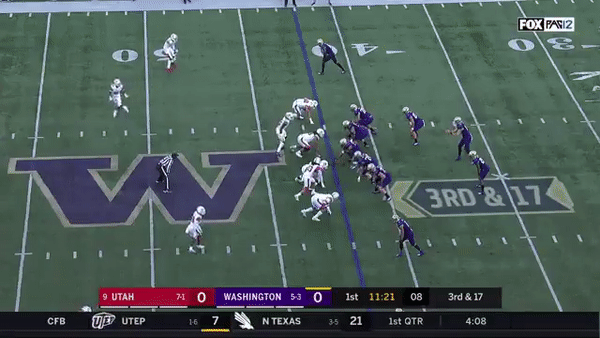
But then this throw later in the game is exactly what teams don’t want to see, an overreaction to pressure vs. a Cover 0 blitz that helped turn an eight-point lead into a loss against the Utes:
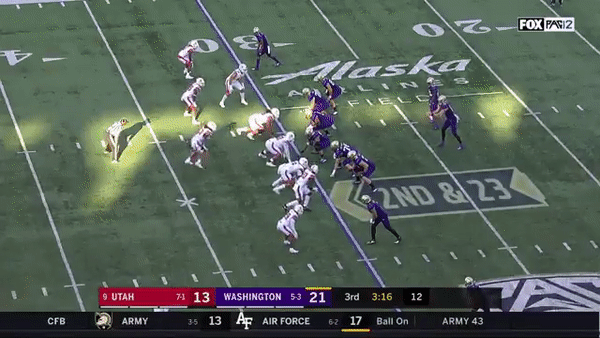
Eason profiles as a Matt Schaub-esque passer in the NFL — and that’s not a total knock when you consider that Schaub had three 4,000-yard passing seasons and made a pair of Pro Bowls (but also had 14 career pick-sixes). Like Schaub, Eason is a system-dependent passer who must land with a coach who is willing to work on developing his shortcomings while highlighting his physical upside.
By the numbers: Against non-conference opponents, Eason completed 67.4 percent of his passes, averaged 277.8 passing yards per game and compiled an 11-1 TD-INT ratio in four games. Against Pac-12 foes last season, Eason completed only 59.5 percent of his passes, averaged 224.6 passing yards per game and compiled a 12-7 TD-INT ratio in nine games.
Interesting fact: Eason’s nickname was “Skinny” growing up, which is interesting for a thickly built adult.
“That came from my dad when he wanted to give me a flat top [haircut] as a kid. It didn’t work out too well. He must have cut it wrong because it looked funny. So he kept cutting. He cut so much that he basically cut it to the skin,” Eason told Yahoo Sports, laughing. “So he just started rubbing my head, and that’s when he started calling me ‘Skinny.’
“A lot of people called me that — coaches, teachers, friends. Pretty much everyone except my mom. She calls me Jacob. She’s not a fan of the ‘Skinny’ nickname. I think it must bring back bad memories of that haircut or something.”
Draft range: Eason could crack Round 1 for a team wanting a developmental future starter, giving the team the fifth-year option on the rookie contract. It wouldn’t stun us if he experienced a slight fall, a la Drew Lock in 2019 when he was drafted 42nd overall by the Denver Broncos.
86. Ohio State WR K.J. Hill
6-foot, 196 pounds
Yahoo Sports draft grade: 5.78
The lowdown: Although Hill’s career production was not stunning, he received the fifth-year bump that has come with other Buckeyes receivers — such as Terry McLaurin and Parris Campbell — finishing first on the Buckeyes in receptions (57), and second in yards (636) and TD catches (10). Hill took the advice of Buckeyes great Cris Carter, who implored him to return to school over declaring last year for the draft.
Hill is not the most physically blessed wideout, but working with one of the best WR coaches in the country (Brian Hartline) has turned Hill into a route ninja and a ball vacuum. He looked to be among the more advanced receivers at the Senior Bowl, even amid a strong collection of talent. Hill is a natural hands catcher (two drops on 75 targets last season, per PFF) and a smart technician who can create separation despite working in close quarters as an underneath and intermediate target.
But that’s also what limits Hill’s NFL projection. He’s likely to predominantly be a slot receiver, lacking the size, explosion or deep speed to win consistently on the outside. He also hasn’t faced much press coverage and wasn’t asked to run many deep routes in college. Hill’s combine workouts and measurables place him pretty low on the WR spectrum.
Still, there’s a role for Hill, likely as a No. 2 (or 3) receiver to complement a speed option and/or a bigger target. We can envision Hill playing a role similar to Jarvis Landry, Cooper Kupp or Tyler Boyd.
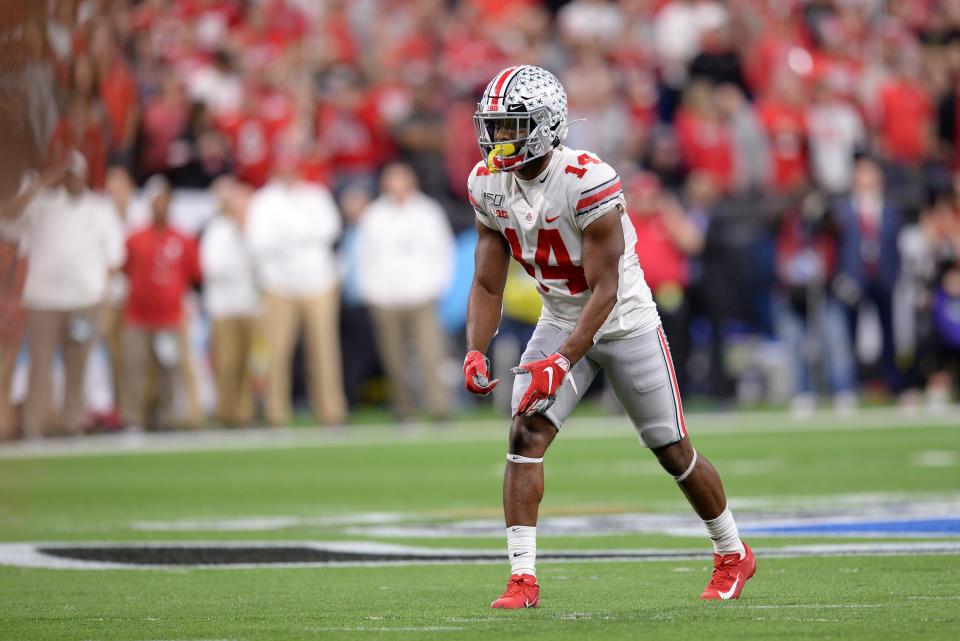
By the numbers: Hill has broken only two catches for 35 yards or longer on his past 183 receptions.
Interesting fact: Would you be shocked to learn that Hill is the Buckeyes’ all-time leader in receptions? The fact that his name appears ahead of David Boston, Santonio Holmes, Ted Ginn Jr., Joey Galloway, Michael Thomas, Carter and others is stunning.
Draft range: Even in a rare year for WR talent in the draft, we’d be surprised if Hill wasn’t picked by the end of Round 4.
85. Virginia CB Bryce Hall
6-foot-1, 202 pounds
Yahoo Sports draft grade: 5.78
The lowdown: Hall was a standout prep receiver but tabbed a 2-star recruit before the Virginia coaches convinced him to give defense a chance. That move paid immediate dividends, as he started seven of his 12 games as a freshman, playing 448 snaps and logging two interceptions.
Over the next two seasons, Hall developed into an All-ACC selection by the conference’s coaches, notching a tremendous 22 passes broken up in 2018, but he opted to return to school for his senior season. Hall was off to a solid start in 2019 before suffering a season-ending ankle injury, having it rolled up on while blocking on a punt return in the second quarter of Virginia’s 17-9 loss to Miami (Fla.) on a rainy field in October. The injury prevented Hall from performing at the Senior Bowl or NFL scouting combine.
When healthy, Hall possesses ideal length for the position to execute press-man coverage and bat away passes at the catch point. What he lacks in great long speed Hall makes up for with outstanding reaction skills and closing ability. He gets his hands on a ton of passes but also has let some potential INTs slip through his fingers. Hall also got a bit grabby last season before getting hurt and was flagged three times in six games, with a couple of pass-interference calls vs. longer receivers (FSU’s Tamorrion Terry and Notre Dame’s Chase Claypool).
Ideally, he’d be used in a zone-heavy scheme that can accentuate Hall’s ability to reroute receivers, operate well in more confined areas and unleash his solid tackling ability (even with the occasional whiff). Hall is not as effective when he’s asked to carry faster wideouts and might always require strong backside safety help in more man-heavy systems.
Hall, who turns 23 years old in November, might have been the clear CB3 in this class had he not gotten hurt at season’s end — and he possibly could have been CB1 or CB2 in a weaker 2019 class had he declared early a year ago.
By the numbers: Hall averaged one pass broken up per 33.7 coverage snaps his first three years combined, according to PFF. But as a senior, he was credited with only one in 199 coverage snaps.
Interesting fact: Hall was named a nominee for the 2019 Allstate AFCA Good Works Team. He has spent time visiting sick children weekly in the hospital during the school year, volunteered at a local Big Brothers & Big Sisters and Boys & Girls Clubs of America, has volunteered weekly and built a foundation with high-school kids at his local church (The Point Church of Charlottesville) and also has visited elderly in assisted-living facilities.
Draft range: Round 3
84. Temple C Matt Hennessy
6-foot-4, 307 pounds
Yahoo Sports draft grade: 5.79
The lowdown: NFL scouts appreciate the intelligence, toughness and work ethic Hennessy will bring to the league, even if his lack of high-end strength is almost certain to limit his ceiling.
A three-year starter, Hennessy learned the center position after joining the program, but he looks like a natural. With strong weight balance, leverage and quick and strong hands, Hennessy makes up for his lack of bulk and power as best he can. Bigger, stronger players give him fits — and this came out in some one-on-one matchups at the Senior Bowl.
We have a hard time picturing Hennessy landing with a gap-blocking team, and he might be a one-position blocker in the NFL, lacking the mass and pop to be much more than a replacement-level guard. His arm length (32 1/4 inches) is barely above the minimum for some teams.
A team running a zone-blocking scheme in need of an intelligent and light-footed center to lead the pass and run games could look at Hennessy as its guy. He’s outstanding on screens, working to the second level with ease, and in the outside-zone series, able to move smoothly and efficiently downfield to lead the way.
It would not surprise us if Hennessy ends up an efficient eight- or 10-year pro.
By the numbers: Hennessy turned in combine numbers that placed him in the 72nd percentile or higher among interior offensive linemen in the 40-yard dash (5.18 seconds), vertical jump (30 inches), broad jump (110 inches), 3-cone drill (7.45 seconds) and short shuttle (4.6 seconds).
Interesting fact: New Carolina Panthers coach Matt Rhule recruited Hennessy to Temple and convinced him to switch to center. And his brother, Thomas, is the New York Jets’ long snapper.
Draft range: Hennessy could land as high as Round 2. He’s not a fit for every team (which is reflected in our conservative grade), but he could be a Year 1 starter for a handful of zone teams.
83. Alabama DL Raekwon Davis
6-foot-6, 311 pounds
Yahoo Sports draft grade: 5.79
The lowdown: Whatever NFL team drafts Davis should demand that he be the first one off the bus. With rare length and mass (and 11-inch hands), Davis fits the mold of an elite athlete for his size. But following a breakout 2017 season in which he notched 8.5 sacks, he hasn’t matched that level since, leaving his NFL projection in the fog.
Davis can impact games without making a play on the ball. He has a long wingspan that can close down passing lanes (even though he was never credited with a batted ball in four years), is good for a few QB hits most games and can load up to take on double-team blocking. Davis also sets the edge well against the run and will shut down gaps by himself.
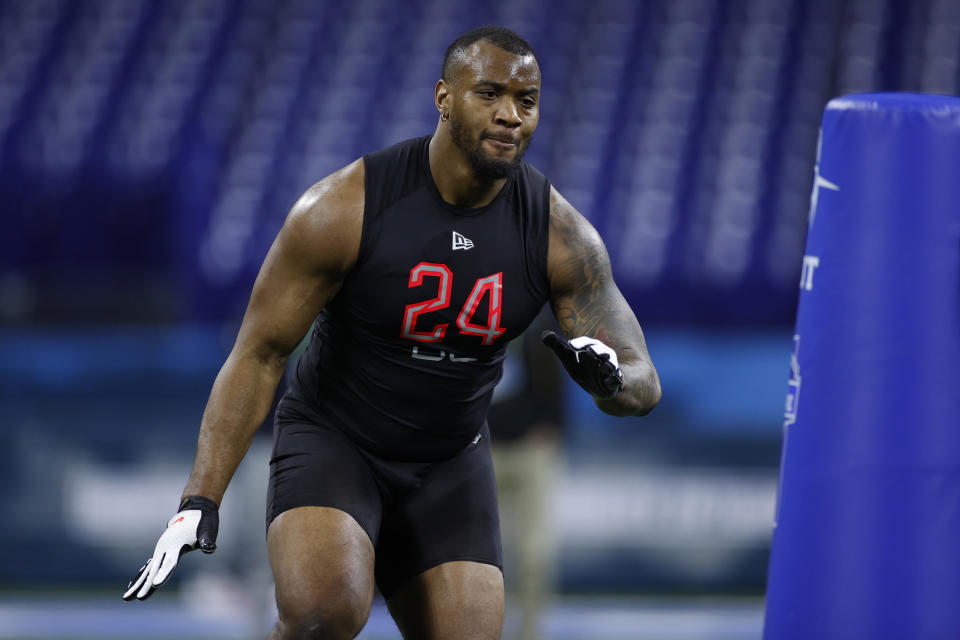
It’s clear that he’s not the first-round prospect many believed he was developing into after a fast start at Alabama. Davis has the kind of power and heavy hands that coaches from the Patriots’ tree and teams that employ a two-gap system will appreciate. But he doesn’t offer much pass-rush potential, doesn’t always locate the ball effectively, will whiff on sacks and TFLs at times and has some character concerns that must be sorted through.
There’s starting potential for Davis in the right system, but the low ceiling for big-play potential limits his overall appeal.
By the numbers: Davis had more sacks (8.5), tackles for loss (10) and fumble recoveries (one) in 2017 than he did in 2018 and 2019 combined (two sacks, 8.5 TFLs, zero fumble recoveries).
Interesting fact: Davis was hit in the right leg by a bullet that was fired outside a bar in Tuscaloosa. Six days later, Davis was cleared for action and had a sack in Bama’s season-opening game against Florida State.
Draft range: Round 3
82. Alabama LB-EDGE Anfernee Jennings
6-foot-2, 256 pounds
Yahoo Sports draft grade: 5.79
The lowdown: Jennings was a 4-star recruit who stayed in his home state of Alabama to play for the Crimson Tide. Although it took him a redshirt season and a freshman year in which he was a reserve, Jennings made his impact felt in 2017 with a solid campaign despite missing time early with a leg injury and in the college football semifinal with a serious knee injury that caused him to miss much of the offseason.
Over the past two seasons, Jennings has been a multi-role starter, able to rush off the edge, drop in short coverage and be a force against the run. The knock on Jennings is that he lacks elite rush skill and has a shorter, squattier frame that makes his NFL position projection tricker.
Jennings is most likely to fit with a defense that runs a 3-4 base, where he can operate on his feet and impact the game with his fairly diverse skills. His football IQ appears strong as Jennings can routinely be seen anticipating runs, timing up snap counts and showing good discipline on misdirection plays.
Although he lacks the kind of burst typically seen in the most productive NFL pass rushers and can play out of control at times, Jennings has a knack for getting tackles off balance with a quality long-arm move and can get blockers to lean the wrong way to generate pressures and sacks. He also anticipates passes well and will swat passes down with more regularity than most players with his length.
Jennings’ upside might be limited, but NFL coaches seeking assignment-sound, diverse and mentally tough defenders can do a lot worse than grabbing him in the second or third wave of the draft.
By the numbers: Jennings was flagged for 10 penalties last season — plus three more that were offsetting or declined — including three games with multiple flags. That was more than Jennings had been called for in his previous three seasons combined.
Interesting fact: Jennings suffered a gruesome knee injury in the Sugar Bowl against Clemson in 2017. That put an end to Jennings’ best game to that point: five tackles (three for loss) and a sack.
What happened after that was shocking. A fan tagged Jennings on Twitter with a photo of the leg after impact from the game, and it scared him — even after receiving a fairly benign initial diagnosis of a sprained PCL. Jennings showed it to a team athletic trainer, who alerted the school’s medical staff. What they found after reexamining Jennings’ leg was artery damage and that his pulse had slowed from the night before. Suddenly, there was serious concern over a possible blood clot — and even the threat of amputation.
Thankfully, it was caught early enough that Jennings saved his leg and played less than eight months later.
Draft range: Round 3
81. Florida EDGE Jonathan Greenard
6-foot-3, 263 pounds
Yahoo Sports draft grade: 5.79
The lowdown: After his solid career at Louisville was cut short by a wrist injury in the 2018 season opener, after a mere 10 snaps, Greenard transferred to the Gators, reuniting with defensive coordinator Todd Grantham (who recruited Greenard when they were with the Cardinals).
It was a terrific decision, as Greenard was named first-team All-SEC with a 9.5-sack, three-forced fumble season in 12 games (with two missed because of injury), outshining returning standout Jabari Zuniga in his one season in Gainesville.
Greenard isn’t an electric rusher around the edge, but he brings outstanding intensity, solid burst and outstanding hand work to his pass-rush approach. He wins with a nice rip move and solid bend, has a great inside rush counter and can finish with regularity. Greenard also is a hard edge setter and looks to dislodge the ball every time he can.
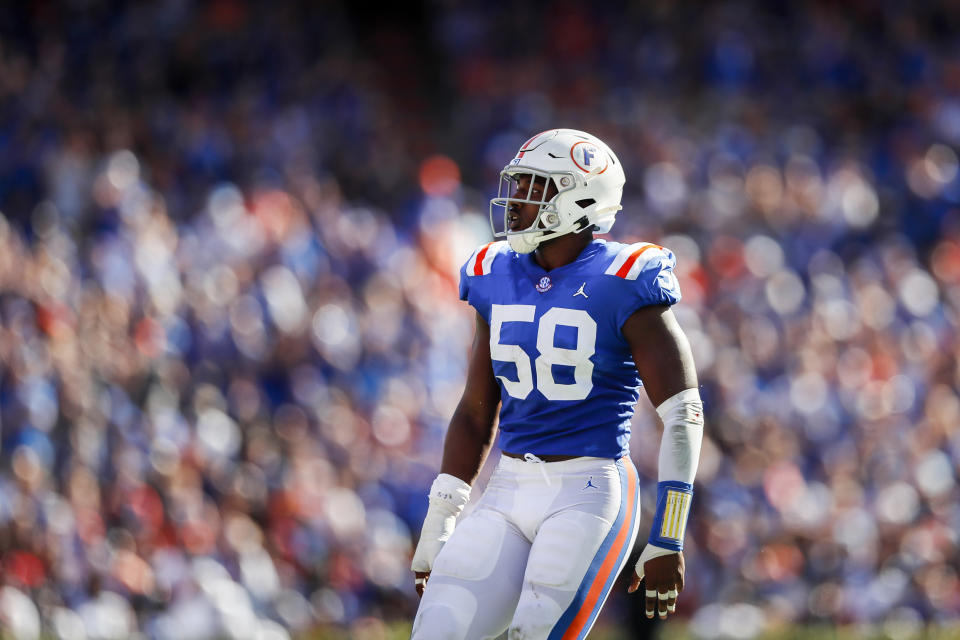
The big knock on Greenard — other than his durability, which will require some scrutiny — is the fact that he didn’t consistently win as a pass rusher against top-tier talent. Although he produced like a madman, racking up six sacks in his final three games, they came against Missouri, Florida State and Virginia. In games against Auburn and Georgia, teams that featured pairs of 2020 tackle prospects, Greenard was held sack-free and relatively in check. (He also was slowed by the ankle injury, which might have had an effect on those games.)
Greenard has a build that suggests he might need to be a 3-4 rush end in a defense such as that of the Pittsburgh Steelers or Chicago Bears, and he likely will need to show he can diversify his game. Greenard also can play too hot under the collar and overrun plays. But following a terrific 2019 season, there’s a lot of promise that he can turn into a solid, productive pro in the right scheme.
By the numbers: Greenard scored the one touchdown by a Gator other than on a run or pass play. It came on his 80-yard scoop-and-score in the third quarter of a 56-0 blowout of Vanderbilt.
Interesting fact: Greenard’s final game at Louisville came at Camping World Stadium in Orlando where he suffered that devastating wrist injury against No. 1 Alabama. And his first game as a Gator — wearing a heavy wrist wrap to protect himself — the following year came at the same stadium vs. Miami.
“I can face my fears,” Greenard said before the game.
He could — and he did. Greenard harassed the Hurricanes with six tackles (two for losses), 1.5 sacks and five QB hurries.
Draft range: Rounds 2 or 3
More from Yahoo Sports:
